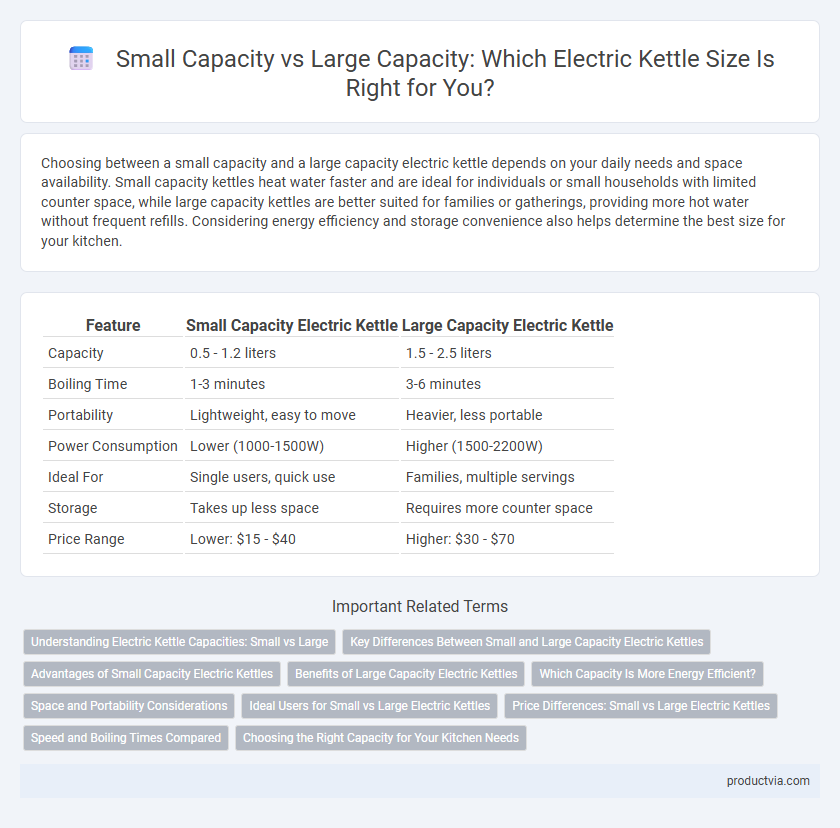Choosing between a small capacity and a large capacity electric kettle depends on your daily needs and space availability. Small capacity kettles heat water faster and are ideal for individuals or small households with limited counter space, while large capacity kettles are better suited for families or gatherings, providing more hot water without frequent refills. Considering energy efficiency and storage convenience also helps determine the best size for your kitchen.
Table of Comparison
| Feature | Small Capacity Electric Kettle | Large Capacity Electric Kettle |
|---|---|---|
| Capacity | 0.5 - 1.2 liters | 1.5 - 2.5 liters |
| Boiling Time | 1-3 minutes | 3-6 minutes |
| Portability | Lightweight, easy to move | Heavier, less portable |
| Power Consumption | Lower (1000-1500W) | Higher (1500-2200W) |
| Ideal For | Single users, quick use | Families, multiple servings |
| Storage | Takes up less space | Requires more counter space |
| Price Range | Lower: $15 - $40 | Higher: $30 - $70 |
Understanding Electric Kettle Capacities: Small vs Large
Small capacity electric kettles, typically ranging from 0.5 to 1 liter, are ideal for quick boiling and energy efficiency, perfect for individuals or small servings. Large capacity kettles, usually between 1.7 to 2 liters, accommodate multiple cups or family needs, reducing the frequency of refills but consuming more power per boil. Choosing the right capacity depends on usage patterns, balancing convenience, boiling speed, and energy consumption for optimal performance.
Key Differences Between Small and Large Capacity Electric Kettles
Small capacity electric kettles typically hold 0.5 to 1 liter, offering faster boiling times and energy efficiency ideal for solo use or limited space. Large capacity kettles, ranging from 1.7 to 2 liters, cater to families or frequent entertaining by providing ample hot water in one boil, reducing the need for multiple heating cycles. The key differences lie in portability, boiling speed, energy consumption, and user requirements based on volume needs.
Advantages of Small Capacity Electric Kettles
Small capacity electric kettles heat water faster, making them ideal for individuals or small households with limited daily water needs. Their compact size saves counter space and enhances portability, suitable for dorm rooms, offices, and travel. Energy efficiency is higher in small capacity kettles as less water requires less power to boil, reducing electricity consumption and costs.
Benefits of Large Capacity Electric Kettles
Large capacity electric kettles offer the advantage of boiling more water at once, making them ideal for families or office settings where multiple cups of tea or coffee are needed quickly. They reduce the frequency of refills, saving time and energy, especially during gatherings or busy mornings. High-capacity kettles often come with powerful heating elements that ensure fast boiling times despite the larger volume.
Which Capacity Is More Energy Efficient?
A small capacity electric kettle is generally more energy efficient for boiling water quickly and using less electricity due to lower volume. Large capacity kettles consume more energy when heating full loads but offer convenience for multiple servings, reducing repeated heating cycles. Choosing the right capacity depends on usage patterns, with smaller kettles best for individual use and larger ones better suited to households or frequent boiling needs.
Space and Portability Considerations
Small capacity electric kettles typically range from 0.5 to 1 liter, making them ideal for limited countertop space and easy portability for travel or office use. Large capacity models often exceed 1.7 liters, providing convenience for multiple servings but requiring more storage area and reduced mobility. Choosing between small and large capacity kettles depends on balancing space constraints with the need for volume and transport ease.
Ideal Users for Small vs Large Electric Kettles
Small capacity electric kettles, typically holding 0.5 to 1 liter, are ideal for individuals or small households who need quick boiling for one to two cups of tea or coffee, offering efficiency and portability. Large capacity electric kettles, ranging from 1.7 to 2 liters, suit families, office environments, or frequent entertainers requiring multiple servings simultaneously, minimizing the need for repeated boiling. Choosing between small and large capacity depends on daily water usage, space availability, and energy consumption preferences.
Price Differences: Small vs Large Electric Kettles
Small capacity electric kettles typically cost less due to lower material and manufacturing expenses, making them budget-friendly options for individuals or small households. Large capacity electric kettles, while more expensive, offer increased convenience for families or gatherings by boiling greater volumes of water faster. Price differences also reflect features such as advanced temperature control and durability often found in higher-capacity models.
Speed and Boiling Times Compared
Electric kettles with small capacity typically boil water faster, often requiring 3-5 minutes for a full boil, making them ideal for quick use and individual servings. Large capacity kettles, ranging from 1.7 to 2 liters, take longer, usually around 6-10 minutes, but are more suitable for families or multiple servings at once. Choosing between small and large capacity depends on balancing the need for speed versus volume in boiling water efficiently.
Choosing the Right Capacity for Your Kitchen Needs
Selecting the right electric kettle capacity depends on your daily water usage and kitchen space. Small capacity kettles, typically 0.5 to 1 liter, offer faster boiling and save energy, ideal for individuals or small households with limited counter space. Large capacity kettles, ranging from 1.5 to 2 liters, suit bigger families or frequent tea and coffee drinkers, ensuring sufficient hot water without constant refilling.
Small capacity vs large capacity for electric kettle Infographic

 productvia.com
productvia.com